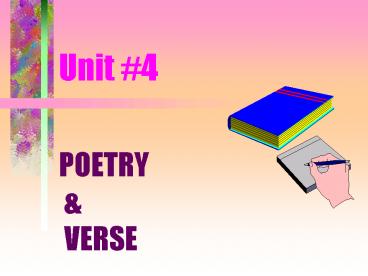Unit - PowerPoint PPT Presentation
1 / 23
Title:
Unit
Description:
Promote Language Learning -- changes thoughts and our language. ... ballads (James Taylor, Billy Joel, Bruce Springsteen, Paul Simon, Dan Fogelberg) ... – PowerPoint PPT presentation
Number of Views:168
Avg rating:3.0/5.0
Title: Unit
1
Unit 4
- POETRY VERSE
2
POETS
NCTE
- David McCord
- Aileen Fisher
- Karla Kuskin
- Myra Cohn Livingston
- Eve Merriam
- John Ciardi
- Lilian Moore
- Arnold Adoff
- Valerie Worth
- Barbara Esbensen
- Eloise Greenfield
- Jane Yolen
- Alison Shaw
- Holling C. Holling
- E. Cohat
- Ronald Rood
- Anita Malnig
3
POETRY CHILDREN
- Intuition of truth.
- Meaning and sound -- arranged in beautiful form
- Carefully selected words
- Understanding is continual process, built on
firsthand experience.
4
Value of Poetry
- Makes us laugh.
- Create images.
- Express feelings.
- Promote Language Learning -- changes thoughts and
our language. - Poet tells us what happens, not what happened.
- Promotes school learning memory, listening,
vocabulary, reading, phonemic awareness,
beginning consonants, writing, thinking.
5
Poetry Promotes Language Learning
- Contains highly charged words.
- Uses only a few words to say a great deal.
- Is melodic -- sings as it says.
- Contains rhythm, repetition, and rhyme.
- Captures the essence of a concept.
- Says more than it says.
- Has layers of meaning.
- Is the natural language of childhood.
6
CRITERIA FOR SELECTION
- Longevity, award winning, widely recognized,
positive literary reviews. - Judge overall nature -- diversity of content,
mood, language use, and variety of forms. - Understandable -- laughter, images, express
feelings. - Appealing -- humorous, strong rhythm rhyme.
- Childrens preferences.
7
Childrens Poetry Choices
- Contemporary
- Understandable
- Narrative
- Rhyme, rhythm and sound
- Relate to personal experiences
- Dislike - figurative language and imagery
- Humorous
8
Classroom Traits
- Girls like more than boys.
- Teachers attitudes practices make difference.
- Read aloud with enthusiasm.
9
Play with Poetry
- Teacher performs -- models
- Students recite as group
- Invite individuals to say short poems
- Ask individuals to recite poems of their own
choosing
10
POETRY LANGUAGE USE
- Elements of sound, rhythm and meaning manipulated
- Sound and rhythm more pronounced
- Meaning more condensed
11
POETRY TECHNIQUES
- Words as sound
- Words as rhythm
- Words as meaning
12
Words as Sound
- Rhyme -- ending sounds
- runover rhyme -- end of one line to beginning of
next - link rhymes --
- Alliteration - repetition of initial consonants
- Assonance - repetition of vowel sounds at close
intervals - Onomatopoeia -- words created from natural sounds
-- associated with thing or action
13
Words as Rhythm
- Recurrence of specific sounds or stressed and
unstressed syllables - Alternating accented and unaccented syllables
- Meter (metrical)-- certain syllables regularly
stressed o accented -- fixed pattern - Manipulation of syntax -- makes distinct from
prose -- creates more meaning than the literal
sense
14
Words as Meaning
- Many layers of meaning -- many interpretations
- Literal/concrete level -- young children
- Figurative Language -- meaning beyond literal
- Metaphor -- comparison -- inferred
- Simile -- comparison -- like or as
- Imagery -- arrest our senses
- Denotation-- literal meaning of word
- Connotation -- suggested meaning of word
15
POETRY FORMS
- Narrative -- tells story
- Lyric - statement of mood or feeling (verses)
- Free verse- -- unrhymed -- arrangement on page
-- concrete poetry - Haiku -- Japanese -- beginning
- Cinquain - unrhymed lines
- Concrete - shape or picture poems
16
Poetry Forms (continued)
- Limerick -- light verse -- 5 lines -- rhyme
scheme of a-a-b-b-a - Ballad -- story told in verse
- folk ballads (John Henry)or literary ballads
(James Taylor, Billy Joel, Bruce Springsteen,
Paul Simon, Dan Fogelberg) - ballads -- heroic deeds, murder, unrequited love,
feuds
17
Poetry Forms (continued)
- Sonnet -- 14 lines, rhymed iambic pentameter
- Petrarchan -- 8 lines, followed by 6 lines
- Shakespearean -- 3-4 line stanzas, followed by
rhyming couplet - themes love, friendship, time, meaning of life
18
MOST ABSTRACT POETRY
- Haiku -- beginning -- natural worlds, particular
event happening at moment - three lines 7 syllables 5, 7, and 5
- Cinquain -- 5 unrhymed lines -- 2-4-6-8-2
syllable pattern - 1 word -- title (noun)
- 2 words -- describing title
- 3 words -- that show action
- 4 words -- that show feeling or emotion
- 1 word -- synonym for title
19
COLLECTIONS
- ANTHOLOGIES COLLECTIONS
- SPECIALIZED - work by several poets on one
subject (holidays, monsters, dinosaurs, horses) - GENERALIZED -- works by many poets on several
subjects - INDIVIDUAL -- WORK OF ONLY ONE POET
20
NCTE AWARD FOR EXCELLENCE IN POETRY FOR CHILDREN
- Given to poets considered to be very best for the
entire body of poets work -- not a single
collection or poem. - 1977 to 1982 -- annually (ran out of poets)
- 1983 to date -- given every 3 years
21
POETRY IN THE CLASSROOM
- Teacher loves it!
- Avoid constant search for meanings.
- Read with delight enthusiasm.
- Surround the children with poetry.
- Begin with favorites -- humorous and narrative --
strong rhyme, rhythm sound elements. - Encourage oral interpretation choral reading,
choral speaking, dramatization. - Copying or writing (cards, posters).
22
POETRY IN THE CLASSROOM
- Make part of daily life -- recite your favorites.
- Dont require memorization -- unless they choose.
- Read several times a day.
- Put on charts.
- Subscribe to poetry supplements.
- Regular time for sharing.
23
POETRY IN THE CLASSROOM
- Encourage clapping or tapping pencils as poems
are read. - Draw pictures in response.
- Discussions.































